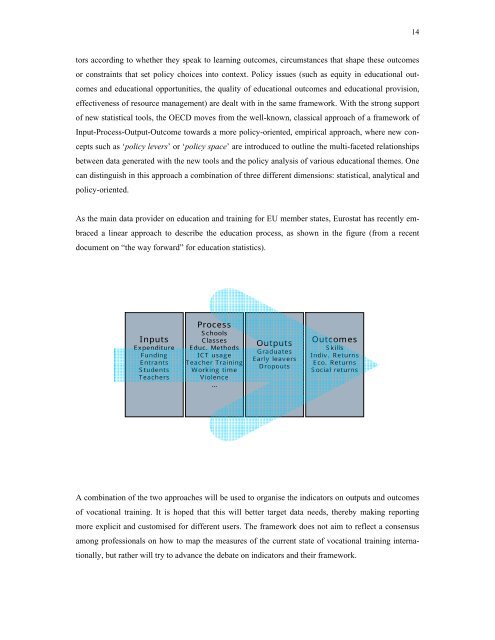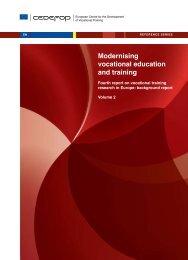measuring the outputs and outcomes of vocational training
measuring the outputs and outcomes of vocational training
measuring the outputs and outcomes of vocational training
Create successful ePaper yourself
Turn your PDF publications into a flip-book with our unique Google optimized e-Paper software.
14<br />
tors according to whe<strong>the</strong>r <strong>the</strong>y speak to learning <strong>outcomes</strong>, circumstances that shape <strong>the</strong>se <strong>outcomes</strong><br />
or constraints that set policy choices into context. Policy issues (such as equity in educational <strong>outcomes</strong><br />
<strong>and</strong> educational opportunities, <strong>the</strong> quality <strong>of</strong> educational <strong>outcomes</strong> <strong>and</strong> educational provision,<br />
effectiveness <strong>of</strong> resource management) are dealt with in <strong>the</strong> same framework. With <strong>the</strong> strong support<br />
<strong>of</strong> new statistical tools, <strong>the</strong> OECD moves from <strong>the</strong> well-known, classical approach <strong>of</strong> a framework <strong>of</strong><br />
Input-Process-Output-Outcome towards a more policy-oriented, empirical approach, where new concepts<br />
such as ‘policy levers’ or ‘policy space’ are introduced to outline <strong>the</strong> multi-faceted relationships<br />
between data generated with <strong>the</strong> new tools <strong>and</strong> <strong>the</strong> policy analysis <strong>of</strong> various educational <strong>the</strong>mes. One<br />
can distinguish in this approach a combination <strong>of</strong> three different dimensions: statistical, analytical <strong>and</strong><br />
policy-oriented.<br />
As <strong>the</strong> main data provider on education <strong>and</strong> <strong>training</strong> for EU member states, Eurostat has recently embraced<br />
a linear approach to describe <strong>the</strong> education process, as shown in <strong>the</strong> figure (from a recent<br />
document on “<strong>the</strong> way forward” for education statistics).<br />
Inputs<br />
Expenditure<br />
Funding<br />
Entrants<br />
Students<br />
Teachers<br />
Process<br />
Schools<br />
Classes<br />
Educ. Methods<br />
ICT usage<br />
Teacher Training<br />
Working time<br />
Violence<br />
…<br />
Outputs<br />
Graduates<br />
Early leavers<br />
Dropouts<br />
Outcomes<br />
Skills<br />
Indiv. Returns<br />
Eco. Returns<br />
Social returns<br />
A combination <strong>of</strong> <strong>the</strong> two approaches will be used to organise <strong>the</strong> indicators on <strong>outputs</strong> <strong>and</strong> <strong>outcomes</strong><br />
<strong>of</strong> <strong>vocational</strong> <strong>training</strong>. It is hoped that this will better target data needs, <strong>the</strong>reby making reporting<br />
more explicit <strong>and</strong> customised for different users. The framework does not aim to reflect a consensus<br />
among pr<strong>of</strong>essionals on how to map <strong>the</strong> measures <strong>of</strong> <strong>the</strong> current state <strong>of</strong> <strong>vocational</strong> <strong>training</strong> internationally,<br />
but ra<strong>the</strong>r will try to advance <strong>the</strong> debate on indicators <strong>and</strong> <strong>the</strong>ir framework.








